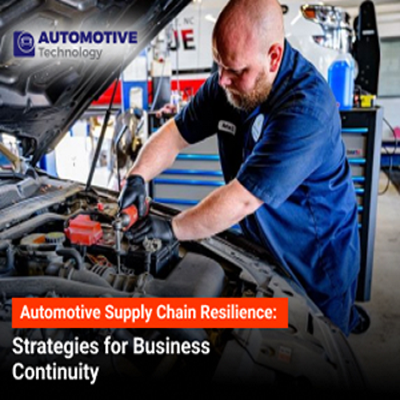Articles
Automotive Supply Chain Resilience: Strategies for Business Continuity

In today's interconnected world, the automotive industry operates within a complex and intricate supply chain network. From the sourcing of raw materials to the delivery of finished vehicles, this chain is susceptible to numerous external and internal disruptions. As we've seen in recent times, unforeseen events such as natural disasters, trade conflicts, and pandemics can critically impact the global supply chain, leading to production delays, cost escalations, and a ripple effect throughout the industry. In light of these challenges, the concept of supply chain resilience has emerged as a vital strategic concern for automotive businesses. This article aims to dissect the key elements of building a resilient automotive supply chain and explores the strategies that can ensure seamless business continuity, even in the face of disruptive events.
Understanding Supply Chain Resilience in the Automotive Sector
In the realm of the automotive sector, supply chain resilience denotes the capability of businesses to effectively navigate and swiftly recuperate from unforeseen disruptions. This involves minimizing the adverse effects on manufacturing and distribution, thereby ensuring seamless operations. Building resilience necessitates a thorough comprehension of the different facets of the supply chain, encompassing sourcing, production, and logistics. It demands a proactive strategy that embeds risk mitigation, adaptability, and nimbleness into all facets of the supply chain.
Identifying Vulnerabilities and Risks in the Automotive Supply Chain
The initial phase in establishing resilience involves recognizing vulnerabilities and potential risks that could disturb the automotive supply chain. These risks may span from scarcities in raw materials and supplier insolvencies to geopolitical instabilities and abrupt shifts in consumer preferences. Through comprehensive risk assessments, automotive enterprises can identify crucial weak spots and devise customized approaches to alleviate these vulnerabilities. Consistent scrutiny and appraisals of suppliers' capabilities, financial robustness, and geographical placements can contribute to the establishment of a more resilient supply chain framework.
Emphasizing Collaboration and Transparency
Collaboration and transparency among all stakeholders are crucial for ensuring a resilient automotive supply chain. Open communication between suppliers, manufacturers, and distributors can foster a better understanding of each other's capabilities and limitations. By establishing strong partnerships based on trust, companies can share information effectively, anticipate potential challenges, and collectively develop contingency plans. Creating a culture of transparency not only fosters stronger relationships but also facilitates the timely identification of issues, enabling quick and coordinated responses to disruptions.
Implementing Technology for Real-time Monitoring and Data Analytics
Employing technology is instrumental in bolstering the resilience of the automotive supply chain. The integration of cutting-edge systems for instantaneous monitoring and data analytics empowers companies to effectively oversee inventory levels, supervise production procedures, and precisely evaluate market patterns. Leveraging advanced software for demand projection and inventory control aids in sustaining optimal stock levels, thereby mitigating the possibilities of shortages or surplus inventory. Moreover, the assimilation of IoT (Internet of Things) devices and sensors within manufacturing plants furnishes valuable observations into machinery functionality, facilitating predictive maintenance and curtailing the risk of unforeseen malfunctions and delays.
Diversification and Redundancy in Supply Sources
Relying on a single source for key components or raw materials can make the supply chain highly vulnerable to disruptions. To enhance resilience, automotive companies should consider diversifying their supplier base and establishing redundancy in critical supply sources. Engaging with multiple suppliers, preferably located in different geographical regions, can mitigate the impact of regional crises and ensure a steady flow of essential materials. While this approach may involve higher initial costs, it significantly reduces the risk of supply chain interruptions and minimizes dependency on a single entity.
Adopting Agile Manufacturing and Production Processes
The ability to adapt quickly to changing circumstances is fundamental for supply chain resilience. Implementing agile manufacturing and production processes allows automotive companies to respond swiftly to fluctuations in demand and supply. By adopting flexible production lines that can swiftly switch between different product variants, manufacturers can adjust output levels based on market demands, thereby minimizing the risk of overproduction or underproduction. The integration of modular production systems and the use of interchangeable components can facilitate rapid adjustments and ensure a more efficient response to unexpected changes in the market.
Creating Contingency Plans and Disaster Recovery Strategies
No matter how robust the supply chain is, there is always the possibility of unforeseen disruptions. To prepare for such contingencies, automotive companies should develop comprehensive contingency plans and disaster recovery strategies. These plans should encompass various scenarios, including natural disasters, geopolitical conflicts, and economic downturns.
Establishing backup production facilities, maintaining emergency inventories, and securing alternative transportation routes can aid in minimizing the impact of disruptions and ensuring the continuity of operations during challenging times.
Investing in Talent Development and Risk Management Expertise
Establishing a robust supply chain demands a proficient workforce proficient in risk management and adept crisis handling. Allocating resources to talent development initiatives that concentrate on augmenting employees' grasp of supply chain intricacies, risk evaluation, and adept crisis handling can notably fortify the organization's capability to maneuver through challenging periods. Cultivating a climate of proactive risk management and furnishing employees with the requisite tools and know-how to make well-informed choices enables automotive enterprises to efficiently mitigate potential disruptions and guarantee uninterrupted operations.
Conclusion
In a time characterized by instability and unpredictability, the durability of the automotive supply chain has emerged as a pivotal element in preserving business flow and upholding a competitive edge. Through proactive identification of weaknesses, promoting cooperation, harnessing technology, broadening supply origins, and dedicating resources to talent enhancement, automotive enterprises can reinforce their supply chain against unforeseen interruptions and emerge resilient in the midst of difficulties. Adopting a comprehensive strategy towards supply chain resilience is not only crucial for securing the sector's activities but also for delivering enduring value to customers and stakeholders, fostering enduring sustainability and advancement.




